Record Arctic Sea Ice Melt to Levels Unseen in Millennia
Posted on 5 September 2012 by dana1981
The record Arctic sea ice decline this year has predictably and deservedly received a fair amonut of media attention. Jonathan Leake of the Sunday Times recently penned an article on the impending sea ice record. The bulk of the article was quite good, but at the end succumbed to the standard mainstream media practice of seeking "balance," thus including some comments by John Christy. Christy has become very reliable for arguing that anything and everything related to climate change probably just boils down to natural variability, as he recently told US Congress was the case with regards to the frequency of extreme weather events, contrary to the body of peer-reviewed scientific literature.
As we will see in this post, Christy once again misrepresented the body of scientific literature with regards to Arctic sea ice extent in his efforts to paint the Arctic sea ice death spiral as nothing out of the ordinary.
2012 vs. 1940
In Leake's article, Christy was paraphrased as saying that there is
"...anecdotal and other evidence suggesting similar melts from 1938-43 and on other occasions."
Christy's comments to Leake via email slightly differed from Leake's paraphrasing, as Christy claimed that evidence suggests summer melts during 1938-43 were "very low extent." This is a rather vague and subjective statement - very low relative to what? Given the context, Leake understandably appears to have assumed that Christy meant very low relative to recent years, and perhaps he did, but it is also possible that he meant 'very low' relative to the early 20th Century, for example.
This begs the obvious question - in the scientific literature, how does Arctic sea ice extent during the period 1938-43 compare to the rest of the 20th Century and current levels? One of the most widely used long-term estimates of Arctic sea ice extent comes from Walsh and Chapman (2001), whose data are available from the University of Illinois (updated through 2008). A description of the vast array of data used by Walsh and Chapman is available via tamino here, and the data are plotted in Figure 1.
Figure 1: Average July through September Arctic sea ice extent 1870-2008 from the University of Illinois (Walsh & Chapman 2001 updated to 2008) and observational data from NSIDC for 2009-2011 (blue), with a fourth order polynomial fit (black soiid line). Black vertical dashed lines indicate the years 1938-43.
Clearly the extent of Arctic sea ice during 1938-43 was nowhere near as low as current levels, based on these data. According to this reconstruction, the minimum extent during that timeframe (9.8 million square kilometers in 1940) was higher than it has been at any time since 1979. In other words, Arctic sea ice extent has been lower than it was in 1938-43 during the entire satellite record, and the current average summer extent is approximately 4.3 million square kilometers lower than the 1940 minimum.
It's true that according to this dataset, 1940 was a local minimum - the lowest Arctic sea ice extent of the 20th Century up to that point, and a minimum that was not repeated again for another 20 years. In that sense one could argue that Arctic sea ice extent at least in 1940 was "very low" compared to the early and mid 20th Century, but compared to the past 20 years it was actually very high. This is also clear from a visual comparison of sea ice extents in 1938 and 2012 (Figure 2).
Figure 2: Arctic sea ice extent from August 2012 from NSIDC (purple) overlaid on a map of sea ice extent in August 1938 from the Danish Meteorological Institute. Red symbols indicate direct observations in 1938.
Henry Larsen, who sailed the Arctic from 1922 to 1948 (including 12 times surviving being stuck in the Arctic ice all winter), tried to sail the St. Roch through the Northwest Passage in 1940. The voyage took more than two years to complete, as the ship struggled through the ice. Larsen gave this firsthand account of the state of Arctic ice at the time:
"The three seasons of the short Arctic Summers from 1940-42 had been extremely bad for navigation, the worst consecutive three I had experienced as far as ice and weather conditions were concerned, and in my remaining years in the Arctic I never saw their like. Without hesitation I would say that most ships encountering the conditions we faced would have failed."
On the other side of the Arctic, Russian martime operations using icebreakers on the Northern Sea Route began in 1932 and give no evidence for improving ice conditions in this period; rather the opposite, as 1937 and 1940 were noted for heavy ice in the Laptev Sea.
Greenland Temperature and Arctic Dominoes
So what was the basis of Christy's claim of "very low extent" in 1938-43? Christy provided two references to support his assertions, Box et al. (2009) and Kobashi et al. (2010). However, neither of these papers involve reconstructions of Arctic sea ice extent; rather, they deal with reconstructing Greenland temperatures, which are not necessarily representative of Arctic temperature as a whole - after all, the continent is covered in a large ice sheet, and the reconstructions are from the summit of the Greenland ice cap, not at sea level.
We contacted Jason Box (lead author of Box et al. 2009), who also noted that local temperatures are not the only factor at play in determining Arctic sea ice extent. During the past two decades, Greenland temperatures have climbed rather steeply, surpassing local temperatures in the 1930s (Figure 3), and even moreso over the whole Arctic (Figure 4). These rising temperatures have been accompanied by unprecedented Greenland ice sheet surface melt. Greenland glaciers have declined (Bjørk et al. 2012) as have Greenland's ice shelves (Falkner et al. 2011). For example, the Ward Hunt Ice Shelf, which was a least 3,000 years old, split off in 2002 (Mueller et al. 2003, England et al. 2008, and Antoniades et al. 2011).
All of this regional ice loss has decreased the local surface reflectivity (albedo), causing the Arctic to absorb more solar radiation, and thus we can expect that similar temperatures now will have a larger impact on sea ice extent than in the past.
Figure 3: Greenland surface air temperature anomalies relative to the 1951-1980 average (Source)
Figure 4: Temperature Anomalies (1951-1981 Baseline) for the Arctic region (64-90°N) over the past 130 years according to ccc-gistemp analysis and NCEP reanalysis data.
In other words, there is a domino effect at play. Human-caused global warming contributes to the summer Greenland warming (Figure 3), which causes snow to melt earlier, which causes decreased local albedo, which contributes to record Greeland ice sheet decline, which further decreases local albedo, which in turn contributes to the Arctic sea ice decline.
2012 vs. the More Distant Past
Christy also claimed that sea ice extent was low 1,000 years ago, as well as in the more distant past. However, his reference for the claim of low sea ice extent 1,000 years ago was again Kobashi et al. (2010), which as noted above, dealt with Greenland temperatures rather than Arctic sea ice extent.
It's important to note that we expect the Arctic to have been cooling over the past ~6,000 years due to the Earth's orbital cycles. Thus if we look back far enough in the past, we can certainly find a period during which the Arctic was hotter and Arctic sea ice extent was lower. However, this actually contradicts John Christy's argument that the current sea ice decline could be natural, because that long-term orbital forcing has not reversed, and thus cannot account for the sudden and rapid Arctic warming and concurrent sea ice decline.
Kaufman et al. (2009) reconstructed Arctic temperatures even further back in time than shown in Figure 5, and confirmed that the Arctic had been cooling for at least the past 2,000 years prior to the 20th Century, and found an Arctic temperature 'hockey stick' (Figure 5).
Figure 5: Arctic temperature change reconstructed by Kaufmann et al. (2009) including data updated for corrigendum and including instrumental measurements for the Arctic region (60 to 90° N) from NASA.
Perhaps the authoritative paper on Arctic sea ice extent over the past 1,450 years is Kinnard et al. (2011), which used a combination of Arctic ice core, tree ring, and lake sediment data to reconstruct past Arctic conditions. The results are shown in Figure 6.
Figure 6: Arctic sea ice extent over the past 1,450 years reconstructed from proxy data by Kinnard et al., with a 40-year low pass filter applied. Note that the modern observational data in this figure extend through 2008, and thus it is a close approximation of current conditions, even though the extent is not as low as current annual data due to the 40-year smoothing.
Based on the Kinnard results, Arctic sea ice extent is currently lower than at any time in the past 1,450 years.
Polyak et al. (2010) looked at Arctic sea ice changes throughout geologic history and noted that the current rate of loss appears to be more rapid than natural variability can account for in the historical record.
"The current reduction in Arctic ice cover started in the late 19th century, consistent with the rapidly warming climate, and became very pronounced over the last three decades. This ice loss appears to be unmatched over at least the last few thousand years and unexplainable by any of the known natural variabilities."
Is the Sea Ice Decline Human-Caused?
The evidence above certainly suggests that humans have played a role in the Arctic sea ice decline, but what does the scientific literature say on the matter?
Vinnikov et al. (1999) estimated the probability that the Arctic sea ice decline could simply be natural. The authors used very long control runs of both the Geophysical Fluid Dynamics Laboratory (GFDL) and Hadley Centre climate models (5,000 years for the GFDL model) to assess the probability that the observed and model-predicted trends in Arctic sea ice extent occur by chance as the result of natural climate variability. They found that large trends in sea ice extent only appeared over short time intervals in the control run, due to natural variability alone. This suggests that natural variability will not cause large long-term Arctic sea ice trends.
Updating this analysis using observational data through 2011 (not even including the 2012 record low sea ice extent), the 32-year trend (1979-2011) is -530 thousand square km per decade, and the 20-year trend is -700 thousand square km per decade. Using the Vinnikov et al. results, these trends both correspond to probabilities of well under 0.1% of being due solely to natural variability.
Day et al. (2012) used five climate models to try and quantify the contribution of natural variations in Arctic sea ice changes. They found that between 5% and 30% of the Arctic sea ice decline from 1979 to 2010 could be attributed to the natural cycles of the Atlantic Multidecadal Oscillation (AMO) and Arctic Oscillation (AO), and even less can be attributed to natural cycles since 1953, since these natural cycles tend to average out over longer timeframes (as Vinnikov also found).
"despite increased observational uncertainty in the pre-satellite era, the trend in [Arctic sea ice extent] over this longer period [1953–2010] is more likely to be representative of the anthropogenically forced component."
Stroeve et al. (2011) noted that in 2009-2010, the AO was in a state which should have resulted in a large sea ice extent; the fact that 2010 was a year of relatively low sea ice extent is indicative long-term human-caused sea ice decline.
"Based on relationships established in previous studies, the extreme negative phase of the Arctic Oscillation (AO) that characterized winter of 2009/2010 should have favored retention of Arctic sea ice through the 2010 summer melt season. The September 2010 sea ice extent nevertheless ended up as third lowest in the satellite record, behind 2007 and barely above 2008, reinforcing the long-term downward trend."
Notz and Marotzke (2012) also found very poor correlation between the AO and Pacific Decadal Oscillation (PDO) and Arctic sea ice extent (yellow and green in Figure 7), concluding:
"the available observations are sufficient to virtually exclude internal variability and self-acceleration as an explanation for the observed long-term trend, clustering, and magnitude of recent sea-ice minima. Instead, the recent retreat is well described by the superposition of an externally forced linear trend and internal variability. For the externally forced trend, we find a physically plausible strong correlation only with increasing atmospheric CO2 concentration. Our results hence show that the observed evolution of Arctic sea-ice extent is consistent with the claim that virtually certainly the impact of an anthropogenic climate change is observable in Arctic sea ice already today."
Figure 7: Correlation between September sea ice extent and CO2 forcing (red), solar forcing (blue), PDO index (green), and AO index (yellow). Figure 4 from Notz and Marotzke (2012).
Global Climate Models Struggle to Account for the Death Spiral
Arctic sea ice has declined at a rate significantly faster than global climate models have predicted. Vinnikov et al. (1999) used the aforementioned GFDL and Hadley Centre climate models, forced by greenhouse gases and sulfate aerosols, to project how Arctic sea ice extent would change in the future. As is the case with most climate models, they under-predicted the ensuing decline (Figure 8). In fact, the Arctic sea ice decline is already 27 years ahead of Vinnikov's projections.
Figure 8: NSIDC annual NH sea ice extent and polynomial fit (red) vs. the GFDL annual NH sea ice extent model and polynomial fit (blue) from 1979 through 2011.
The global climate models used in the 2007 IPCC report also failed to acount for the extent of Arctic sea ice loss (Figure 9).
Figure 9: Actual observations of September Arctic sea ice, in red, show a more severe decline than any of the 18 computer models, averaged in a dashed line, that the 2007 IPCC reports reference (NSIDC)
As Stroeve et al. (2012) discuss, newer climate models have made some progress in this area, but still cannot account for the full extent of the Arctic sea ice decline.
"Previous research revealed that the observed downward trend in September ice extent exceeded simulated trends from most models participating in the World Climate Research Programme Coupled Model Intercomparison Project Phase 3 (CMIP3). We show here that as a group, simulated trends from the models contributing to CMIP5 are more consistent with observations over the satellite era (1979–2011). Trends from most ensemble members and models nevertheless remain smaller than the observed value."
This may be due to the difficulty in accounting for natural variations, or the physics associated with the domino effect discussed above, or both. There are some regional models (i.e. see the model of Maslowski et al., also discussed here) which have had success in accounting for and predicting Arctic sea ice changes, but climate models overall have been too conservative in projecting the rapid decline in Arctic sea ice.
Human-Caused Arctic Sea Ice Death Spiral
The scientific literature is clear that the current record Arctic sea ice decline is beyond what has occurred due to natural variability for at least the past several millennia, certainly beyond what occured circa 1940, and that human influences are primarily responsible for the rapid rate of the death spiral. The rapid Arctic warming appears to have caused a domino effect by resulting in record ice melt and thus a significant decrease in local albedo, and therefore an increase in absorbed solar radiation. The rapid warming and increased solar radiation absorption have combined to result in younger, thinner Arctic sea ice, which therefore melts more easily, making record low extents more likely to occur.
It is wishful thinking to believe that the Arctic sea ice death spiral could simply be due to natural variability. The scientific literature clearly shows that human-caused warming is the main driver behind this exceptionally rapid decline.
Note: this post has been incorporated into new rebuttals to the myths Arctic sea ice loss in the 1940s was similar to today's, Arctic sea ice extent was lower in the past, and to update the Intermediate rebuttal to Arctic icemelt is a natural cycle. The two new rebuttals also have short URLs http://sks.to/arctic1940 and http://sks.to/pastarctic. Our list of short URLs https://skepticalscience.com/shorturls.php is also a useful resource for tweeting and posting in blog comment threads.































 Arguments
Arguments





















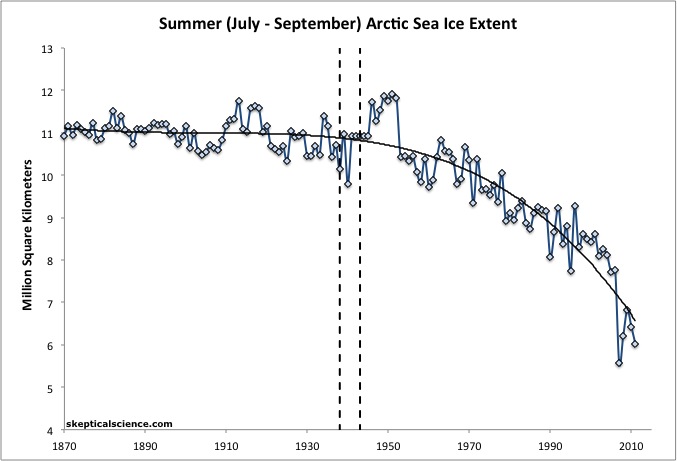
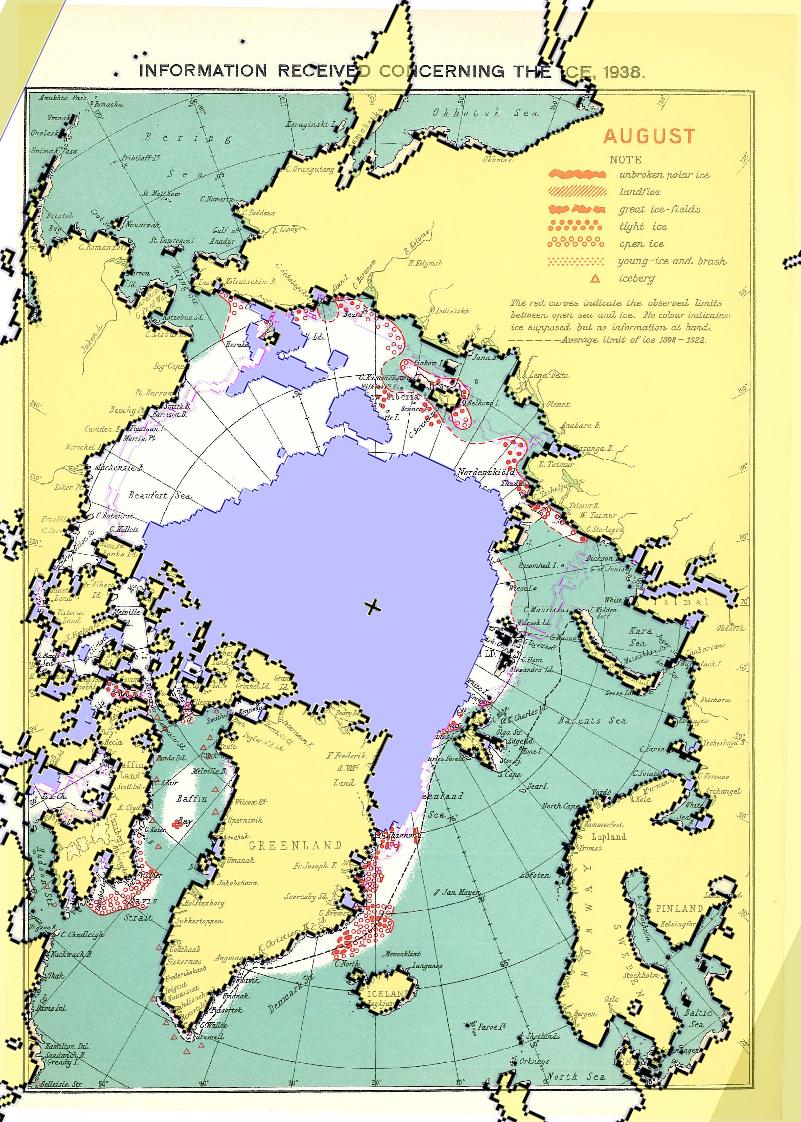

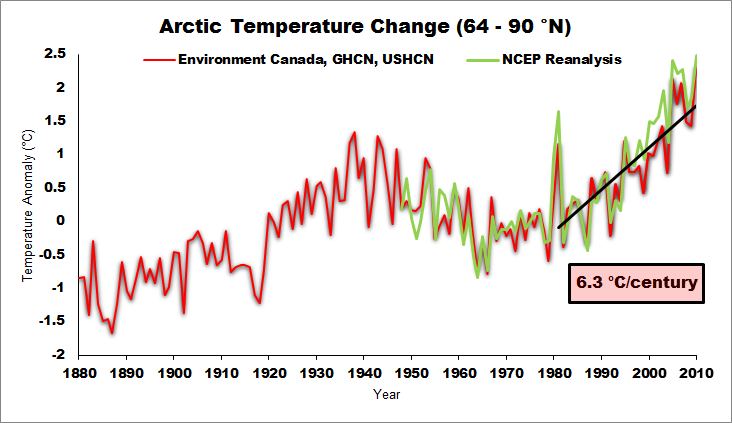
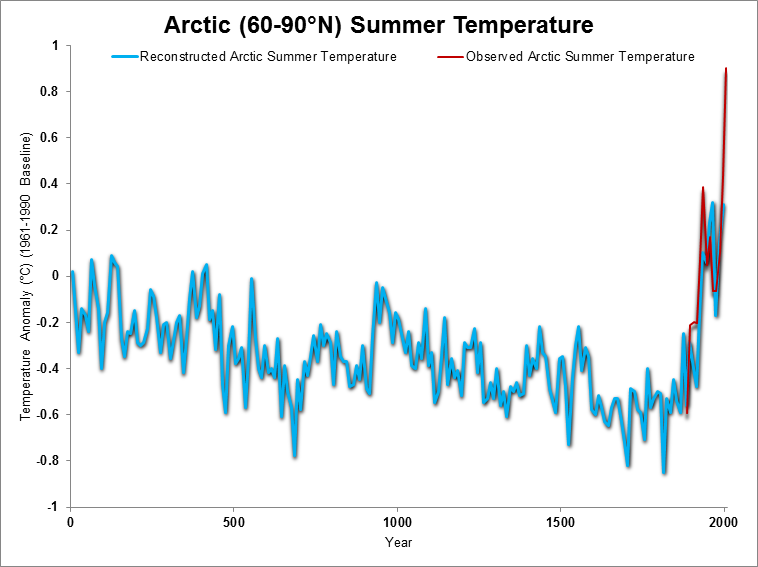
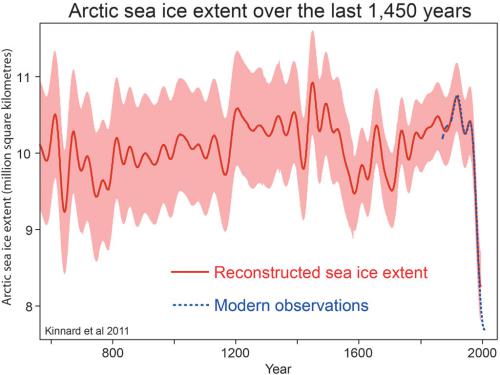
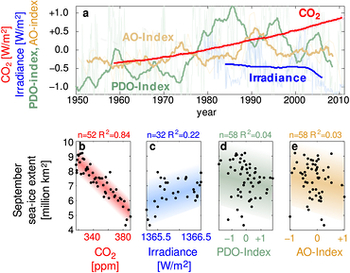
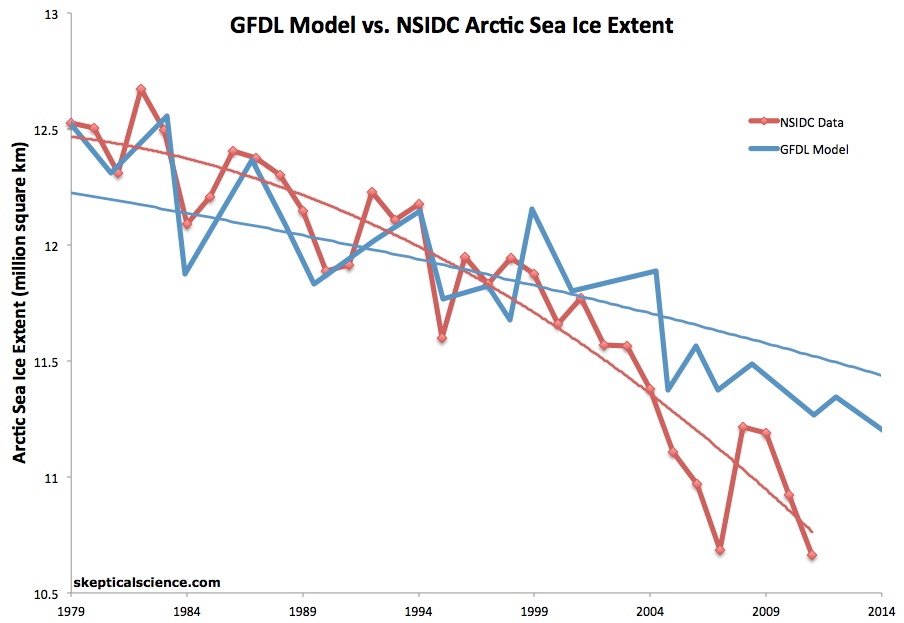










[DB] Please note that posting comments here at SkS is a privilege, not a right. This privilege can and will be rescinded if the posting individual continues to treat adherence to the Comments Policy as optional, rather than the mandatory condition of participating in this online forum.
Moderating this site is a tiresome chore, particularly when commentators repeatedly submit offensive or off-topic posts. We really appreciate people's cooperation in abiding by the Comments Policy, which is largely responsible for the quality of this site.
Finally, please understand that moderation policies are not open for discussion. If you find yourself incapable of abiding by these common set of rules that everyone else observes, then a change of venues is in the offing.
Please take the time to review the policy and ensure future comments are in full compliance with it as no further warnings will be issued.
[DB] Fixed typos per request.
Fascinating? No. Merely interesting.